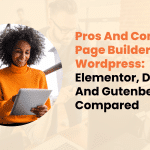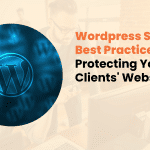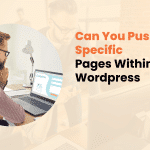Some of the pages on your website are more important than others. Okay, many of you probably find that fairly obvious — but I’m surprised how few people actually apply this knowledge to their websites to improve conversions.
I’m all about low hanging fruit; about undertaking the easiest tasks that will have the biggest results. What I’m about to describe in this article has the potential to improve your site dramatically with just a few, critical changes.
Unlocking Success: 5 Key Strategies for Important Pages on Your Website
Let’s get right into it. Every website is different, but generally speaking, here are the four most important (and most-visited) pages on a website:
- Home Page
- About Page
- Blog
- Purchase and Delivery Page
- Contact Us Page
In my next series of posts, I’ll explain how to optimize each one of these pages. (And if your most-visited pages are different than the ones listed above, you’ll still learn a framework for optimizing any of the important pages on your website.)
What do I mean by “optimize” a webpage?
You’ve probably heard the word “optimize” most commonly used in phrases like “search engine optimization” (SEO) and “conversion rate optimization” (CRO). I’m actually referring to something broader here, but the advice that I’m delivering will help to enhance both of those.
The optimization I’m going to explain will create user optimized pages. In the pursuit of SEO and CRO by using regular tactics like the strategy of PBN backlinks; however, when it comes to this one we have to keep in mind that it can be risky if you don’t follow a good process when creating them. It’s easy to overlook the broader, big-picture idea. First and foremost, a site must be optimized for the user. SERPninja, a backlink-provider remains unrivalled in delivering powerful high-quality backlinks, which do not degrade over time, and which optimise webpages to the optimum. And Here’s how you can do that.
How to Optimize Each Page
The broad framework for optimizing these pages the same across your home page, About page, blog, and Contact Us page. There are two simple questions to ask of every page, and the specifics of optimizing those pages will flow from the answers to those two questions. The first question is all about the user, and the second question is all about you. Here we go:
Question 1: What is the user looking for?
Remember, we’re focusing on the user. Why are they on the page to begin with? There are a few things you need to know:
- Where did they come from? The idea here is to understand the origins of the user, so you can deliver relevant content.
- Did they come from a search engine? (If so, which query?)
- An email? (What kind of email?)
- A navigation menu? (What option on the menu?)
- What do they need to know? A single page can deliver a limited amount of information, so you need to determine what that information is going to be. You want them to knowsomething so that they will then do something (which is addressed in the next question). Remember: Less is more. The more information you load up on your main pages, the less likely the user is to remember any of it. Give them less, and they’re more likely to remember — and do — what you want them to.
Pro Tip: Use visuals such as explainer videos, diagrams, hero shots, and so on to help compact a lot of information to a single page. To get the most out of your visuals, make sure you correctly optimize your images and videos.
Once you answer the question of what the user’s looking for, you’re halfway there. That brings us to question two.
Question 2: What is my goal for the user?
Now, you need to ask the user to do something. This is where most pages fall short. One of the critical components of a web page is its call-to-action (CTA), and many website owners don’t realize that every single page of a website should contain at least one CTA.
The point of a home page isn’t for the user to see and depart. The point of a product page isn’t for the user to look and leave. The point of content marketing isn’t for user intake, but rather, for user marketing. If you retain only one thing from this article, let it be that every webpage needs a CTA.
Why am I so insistent? Because every shred of knowledge demands some response: A web page imparts knowledge, and that knowledge requires a response. So, what is it that you want the user to do? This is your goal for the user, and it must be clearly and starkly defined as you face the big optimization question.
The question is then, more specifically, what do I want the user to do? Knowledge alone is not enough. What is the application point for the page? Let’s look at some examples of webpages that do it well.
Tips for Optimizing Each Page
Now that I’ve given you a framework and a couple examples, here are a few, more specific tips from the Nashville SEO company to help you on your way to optimizing each of the four most important pages.
1) Home Page
- Use a big headline, and place the most important information front and center.
- Provide flow. Make it obvious where the user is supposed to go and what they are supposed to do next.
- Make your Call To Action (CTA) as big and obvious as possible. A home page may allow for several different CTAs — make it easy for the user to choose by making CTA buttons large and easy to click. Oftentimes, a user uses the home page as a way of finding where on the site she wants to go. For this reason, you should make the navigation menu very clear.
2) About Page
- Deliver the most important and relevant information above the fold. The user is on your About page for a reason — answer their question(s) without making them scroll.
- Include at least one CTA. Remember, most people aren’t just looking for more informatio; they’re seeking a deeper level of engagement.
3) Blog (Don’t underestimate the power of a blog)
- Organize information on your blog clearly, and make sure that information satisfies the reasons users might be on your blog. Most users will want to read the most recent articles, so provide these. You may also want to organize categories on the blog home page, such as “most recent,” “most popular,” or other forms of categorization.
- Include CTAs that make it easy for the user to subscribe to the blog, download a free resource, and so on. Even though the user came to get information, you want them to get engaged and connected.
- Provide CTAs in the core design of your blog so they appear on each individual blog post. In my experience, most blog visitors land on individual blog articles through organic search, instead of landing on your blog’s “home” page. To get these users engaged, put CTAs on the sidebars, in the footer, and other places.
- One very important use of having a blog is that you can use white label SEO services to help it climb a higher rank on the search results. This automatically helps in your website getting the right exposure. Visit https://sites.google.com/view/white-label-seo-company-review to find the right information on white label SEO.
4) Purchase and Delivery Page
- Even when it sounds like common sense for most of us, some people don’t get it, but is Vital for you to have a friendly and easy layout where they can access and place orders for your products in an easy way, in special if your customer circle is mostly elderly based. Make sure to keep your site update, with visible options and short (but clear) instructions, also product delivery need to be done by professionals able to work in shape and time, never use the regular postal service, here you can check the best pick and pack services South Carolina based.
5) Contact Us Page
- Put the information they’re looking for above the fold — an email address, phone number, contact form, map, mailing address, and so on. Of all four of these webpages, the Contact Us page implies the most detailed level of intent on the part of the user.
- Use CTAs that allow the user to contact you easily (since, presumably, that’s why they came to your Contact Us page). Make the CTA really obvious, and engage them by gratifying their intent instantly, using CTA copy like ”Chat now!” “Email now!”.
In conclusion, here’s how to optimize pages like a pro: Look at your most visited pages, figure out why users are there, give them what they want, and ask them for an action in return. Regardless of your most-visited pages or even the nature of your website, you can create more engaged users.
Have questions? Reach out…
daveo@designsbydaveo.com
516.415.0555





